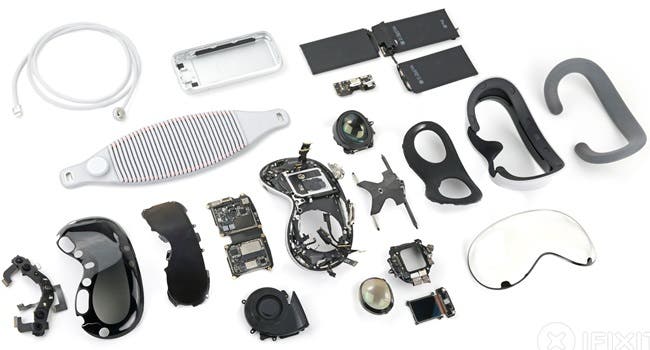The Apple Vision Pro, hailed as a revolutionary advancement in mixed reality headsets, has undergone a meticulous teardown and video examination by the renowned repair experts at iFixit. This in-depth exploration offers valuable insights into the device‘s intricate design, addressing concerns about weight, potential repair costs, and overall repairability.
Inside Apple Vision Pro: Design Secrets and Repair Risks

Weight Distribution and Potential Discomfort:
One of the first issues tackled in the teardown is the Vision Pro’s weight, exceeding a kilogram and raising concerns about long-term comfort. The heavy glass panel, estimated to cost a staggering $799 for replacements, contributes significantly to the bulk. Additionally, the battery pack, comprised of three iPhone-sized batteries. Further adds weight and is positioned in a front-heavy manner, potentially causing balance issues. While iFixit speculates on a patented rear-mounted battery design, such a configuration could exacerbate the weight problem. Compared to competitors like the Quest Pro and Quest 3, the Vision Pro’s hefty weight might become noticeable during extended use.

Modular Design and User-Friendly Elements:
Despite the weight concerns, the teardown reveals positive aspects of the design. The Solo Knit Band, frequently presented in promotional materials, lives up to its name. Offering a comfortable and adjustable fit. iFixit commends the easily removable speaker modules, attached to rigid bands with a SIM-card removal tool, mirroring the modularity seen in AirPods Max. This element suggests potential user-friendliness when servicing or replacing these components.

Exploring Apple Vision Pro: Features and Repairability Issues
Customization and Attention to Detail:
Further enhancing the user experience, Apple provides an impressive 28 different light-seal parts to accommodate diverse face shapes and sizes. The magnetically attached seals allow for a personalized fit, showcasing Apple’s commitment to customization. Notably, the absence of a “standard” setup necessitates hand-packing each Vision Pro order, highlighting the company’s focus on individual needs.

EyeSight Display: Innovation with Compromises:
The highly debated EyeSight display, promising a realistic 3D-looking face, undergoes scrutiny in the teardown. It reveals three modes – internal focus, external engagement, and do not disturb – but user reviews express dissatisfaction with the display’s low resolution and underwhelming brightness. Despite the innovative approach, iFixit notes several complexities within the front-facing display, suggesting compromises made to achieve Apple’s vision. For users requiring corrective lenses, the ovoid inserts offering automatic interpupillary distance adjustment are a welcome feature, although limitations exist for those with astigmatism. Powering the device is the M2 Mac chip, partnered with the R1 chip for sensor processing, aiming to minimize latency during augmented reality experiences.

Repair Challenges and Ongoing Exploration:
While acknowledging the Vision Pro’s cutting-edge technology, iFixit raises concerns about its repairability. Although some elements show user-serviceability, the overall repairability score remains low. Specifically, iFixit criticizes the EyeSight screen, questioning its durability and the potential high cost of replacements due to its complex build. They conclude by expressing their intention to delve deeper into the internal displays and sensor arrays. And eventually provide a final repairability score for the Vision Pro.

Conclusion:
The Apple Vision Pro teardown offers a fascinating glimpse into its intricate design and reveals both innovative features and areas for improvement. While users might appreciate the modularity, customization options, and powerful processing, concerns regarding weight, display quality, and repairability remain valid. As iFixit’s exploration continues, a clearer picture of the Vision Pro’s strengths and weaknesses will emerge. Helping potential buyers make informed decisions.

A Remarkable Achievement, Marred by an Unusual Design Choice
Similar to the original iPhone, the Vision Pro prioritizes a seamless user experience. The iPhone employed a gray-and-white checkerboard during performance struggles, favoring responsiveness over graphical fidelity. However, Apple’s current approach focuses on both graphics fidelity and responsiveness, albeit at the expense of battery life, weight, and heat. This trade-off, driven by the significance of the AR experience, seems justified for a first-generation device.
The Vision Pro is undeniably ambitious, combining the power of a Mac and a dedicated AR chip in a wearable computer. While it is heavy with fragile glass and a tethered battery, the device impresses with its innovative design, despite some repairability challenges. Notably, the side arms can be easily removed with a SIM-removal tool, showcasing thoughtful connections and user-friendly magnetic cushions.
Despite the meticulous development process, Apple falls short of its own standards with the EyeSight screen on the Vision Pro. The screen is dim, low-resolution, and adds considerable bulk, weight, complexity, and cost to the headset’s most weight-sensitive component. The reasons behind this discrepancy – whether a missed performance target, a late-stage manufacturing error, or a challenging market decision – remain unclear.
Having disassembled VR headsets since the original Oculus, our team is consistently amazed by the mechanical and optical design intricacies. Apple’s integration of sensors for robust location tracking stands out, promising a deep dive into the mechanics in future analyses.
The exploration is ongoing, with upcoming examinations of internal displays, sensor arrays, and a repairability score. Stay tuned on social media or return here for further insights into IPD calibration motors, cooling mechanisms, specific chips, or circuitry. There’s much more to uncover in the fascinating world of the Vision Pro.





